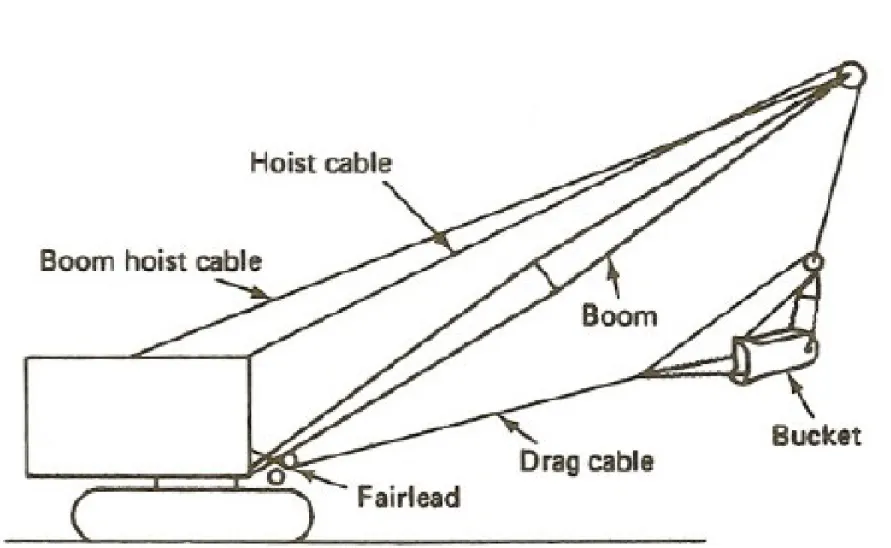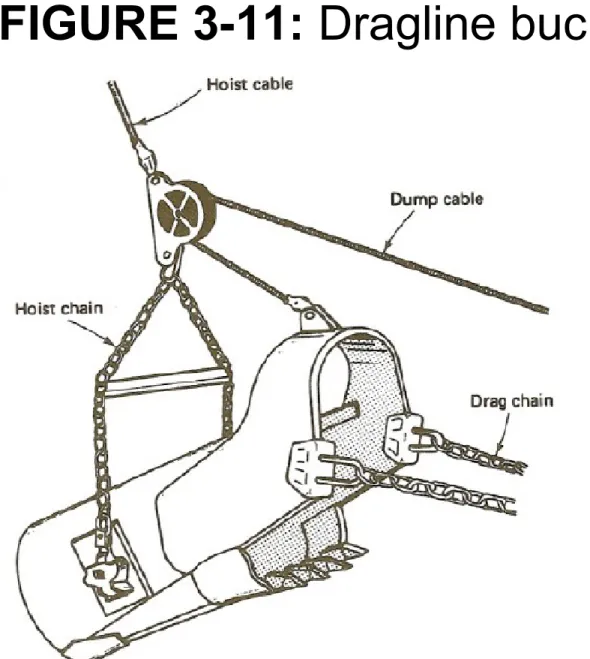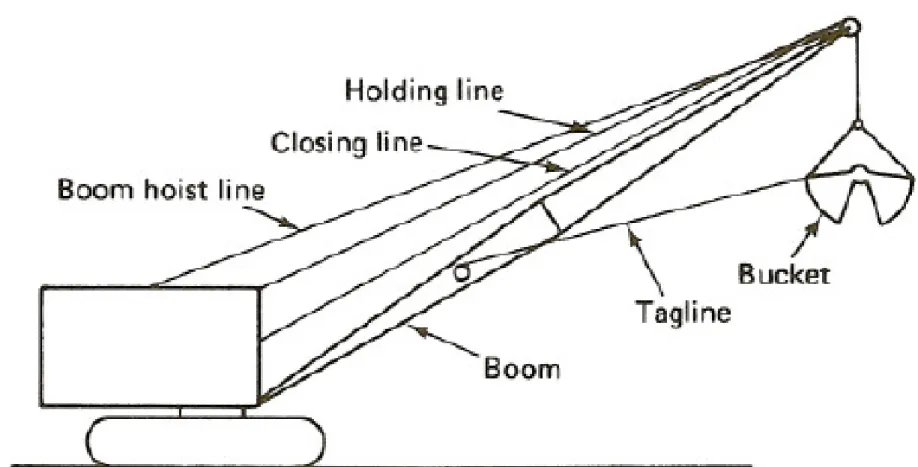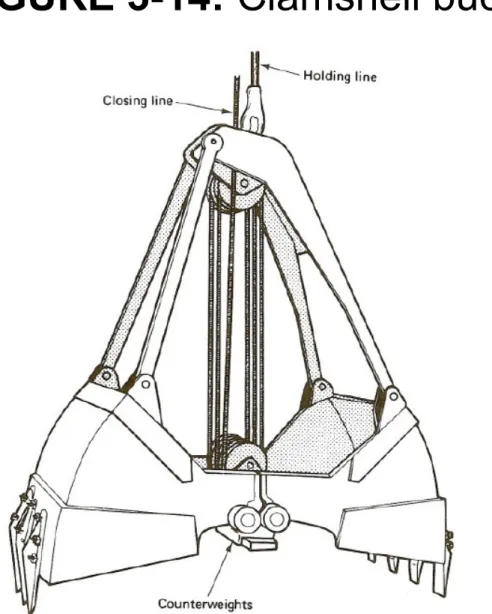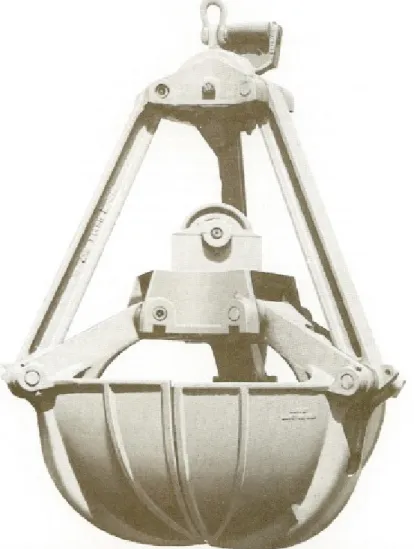Chapter 3
Excavating and Lifting
Part 2
3-4 DRAGLINES
• Operation and Employment
• Production Estimating
• Job Management
Operation and Employment
• The dragline :
– It is a very versatile machine that has the longest reach for digging and dumping of any member of the crane-shovel family.
– It can dig from above machine level to significant depths in soft to medium-hard material.
– The components of a dragline are shown in Figure 3-10.
FIGURE 3-10: Components of a dragline.
3-4 DRAGLINES
– Bucket teeth and weight produce digging action as the drag cable pulls the bucket across the
ground surface.
– Digging is also controlled by the position at
which the drag chain is attached to the bucket (Figure 3-11).
FIGURE 3-11: Dragline bucket.
3-4 DRAGLINES
• It is a very versatile excavator,
• it does not have the positive digging action or lateral control of the shovel. Because of that:
– the bucket may bounce or move sideways during hard digging.
– More spillage must be expected in loading than would occur with a shovel.
3-4 DRAGLINES
• The maximum bucket size to be used on a dragline depends on machine power, boom length, and material weight.
– Therefore, use the dragline capacity chart provided by the manufacturer instead of the machine's lifting capacity chart to determine maximum allowable bucket size.
3-4 DRAGLINES
• To estimate dragline production using the tables,
– determine the ideal output of the dragline for the machine size and material (Table 3-7),
– then adjust this figure by multiplying it by a swing- depth factor (Table 3-9) and a job efficiency factor, as shown in Equation 3-3.
• Expected production = Ideal output × Swing-depth factor
× Efficiency (3-3)
– Notice the conditions applicable to Table 3-7 given in the footnote..
3-4 DRAGLINES
• To use Table 3-9, it is first necessary to
determine the optimum depth of cut for the
machine and material involved from Table 3-8.
• Next, divide the actual depth of cut by the optimum depth and express the result as a percentage.
3-4 DRAGLINES
• The appropriate swing-depth factor is then obtained from Table 3-9,
– interpolating as necessary.
• The method of calculating expected hourly production is illustrated in Example 3-4.
EXAMPLE 3-4
• Determine the expected dragline production in loose cubic yards (LCM) per hour based on the following information.
– Dragline size = 2 cu yd (1.53 m3) – Swing angle = 120o
– Average depth of cut = 7.9 ft (2.4 m) – Material = common earth
– Job efficiency = 50 min/h – Soil swell = 25%
EXAMPLE 3-4
Solution
Ideal output =230 BCY/h (176 BCM/h)
(Table 3-7)
Optimum depth of cut = 9.9 ft (3.0 m)
(Table 3-8)
Actual depth/optimum depth = 7.9/9.9 × 100 = 80%
[= 2.4/3.0 × 100 = 80%]
EXAMPLE 3-4
Swing-depth factor=0.90 (Table 3-9) Efficiency factor =50/60 = 0.833
Volume change factor = 1 + 0.25 = 1.25
Estimated production = 230 × 0.90 × 0.833 ×1.25 = 216 LCY/h
[= 176 × 0.90 × 0.833 ×1.25 = 165 LCM/h]
Job Management
• Trial operations may be necessary to select:
– the boom length, – boom angle,
– bucket size and weight, and
– the attachment position of the drag chain that yield maximum production.
• As in shovel operation, maximum production is obtained with a minimum swing angle.
Job Management
• Special bucket hitches are available which shorten the drag distance necessary to
obtain a full bucket load.
• Deep cuts should be excavated in layers whose thickness is as close to the
optimum depth of cut as possible.
3-5 CLAMSHELLS
• Operation and Employment
• Production Estimating
• Job Management
3-5 CLAMSHELLS
Operation and Employment
• When the crane-shovel is equipped with a crane boom and clamshell bucket, it
becomes an excavator known as a clamshell.
• The clamshell is capable of excavating to great depths.
• The shovel and backhoe is better than clamshell because of :
– lacks the positive digging action and – precise lateral control.
FIGURE 3-13: Components of a Clamshell
3-5 CLAMSHELLS
• Clamshells are commonly used for:
– excavating vertical shafts and footings,
– unloading bulk materials from rail cars and ships, and
– moving bulk material from stockpiles to bins, hoppers, or haul units.
FIGURE 3-14: Clamshell bucket
3-5 CLAMSHELLS
• Bucket penetration depends on bucket weight assisted by the bucket teeth.
• Therefore, buckets are available in light,
medium, and heavy weights, with and without teeth.
1. Heavy buckets: are suitable for digging medium soils.
2. Medium buckets: are used for general-purpose work, including the excavation of loose soils.
3. Light buckets: are used for handling bulk materials such as sand and gravel.
3-5 CLAMSHELLS
• The orange peel bucket illustrated in Figure 3-15 is principally utilized for underwater
excavation and for rock placement.
• Because of its circular shape, it is also well suited to excavating piers and shafts.
• It operates on the same principle as does the clamshell.
FIGURE 3-15: Orange peel bucket.
(Courtesy of ESCO Corporation)
3-5 CLAMSHELLS
Production Estimating
• No standard production tables are available for the clamshell.
– Thus production estimation should be based on the use of Equation 2-1.
– The procedure is illustrated in Example 3-5.
EXAMPLE 3-5
• Estimate the production in loose cubic yards per hour for a medium-weight
clamshell excavating loose earth.
– Heaped bucket capacity is 1 cu yd (0.75 m3).
– The soil is common earth with a bucket fill factor of 0.95.
– Estimated cycle time is 40 s.
– Job efficiency is estimated at 50 min/h.
EXAMPLE 3-5
Solution
Production = 3600/40 × 1 × 0.95 × 60/50 = 71 LCY/h
B = 3600/40 × 0.75 × 0.95 × 60/50 = 53 LCM/h
Job Management
• The maximum allowable load (bucket weight plus soil weight) on a clamshell should be obtained from the
manufacturer's clamshell loading chart for continuous operation.
Job Management
• limit the load to 80% of the safe lifting
capacity given by the crane capacity chart for rubber- tired equipment or 90% for
crawler-mounted equipment.
• use of the lightest bucket capable of
digging the material will enable a larger
bucket to be used and will usually increase production.
Job Management
• Cycle time is reduced by organizing the
job so that the dumping radius is the same as the digging radius.
• Keep the machine level to avoid swinging uphill or downhill.
• Nonlevel swinging is hard on the machine and usually increases cycle time.
